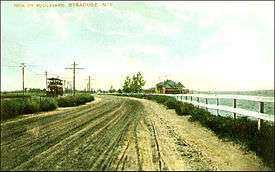Syracuse, Lakeside and Baldwinsville Railway
| Locale | Syracuse, New York to Baldwinsville, New York |
|---|---|
| Dates of operation | 1898–1905 |
| Successor | Syracuse, Lake Shore and Northern Railroad |
| Track gauge | 4 ft 8 1⁄2 in (1,435 mm) standard gauge |
The Syracuse, Lakeside and Baldwinsville Railway began operations in 1898[1] and provided service along the shore of Onondaga Lake outside of Syracuse, New York. Due to dependence on summer traffic, the company did not prosper during the remainder of the first year;[2] however, during 1899, the rail was extended to Baldwinsville, a suburb, and the line began to handle daily commuter traffic.
The company ran double-deck cars for several years which were a real novelty since they were the only ones in Central New York. They were eventually abandoned because of safety reasons,[3]
By late 1903, the road fell into bankruptcy and in the summer of 1905 the road was purchased on mortgage foreclosure by Clifford D. Beebe and was reorganized as the Syracuse, Lake Shore and Northern Railroad.[2]
History

Application was made on June 2, 1898, under section 68 of the Railroad Law, to the Senate of New York State for a determination of the manner in which the railroad crossed the tracks of both the New York Central Railroad and Hudson River Railroad Company at a point near Onondaga Lake in Onondaga County. The Board of Railroad Commissioners determined that the railroad could cross the lines be means of an overhead bridge and that the proportion of expense would be borne by the street railroad company.[4]
The road was built as a local investment both in construction and matters of finance. The majority of the construction took place in 1899, with the opening to Baldwinsville taking place on September 24 that year. Prior to that date, the road had been operated to lakeside resorts such as Pleasant Beach in Fair Haven on Lake Ontario. This "stirred up a lively opposition" from the Delaware, Lackawanna and Western Railroad(DL&WRR), which laid a branch track at Maple Bay on the north end of Onondaga Lake. DL&WRR started a price war, both to the resorts, and later, when the Lakeside tracks were completed to Baldwinsville.[3]
The Lakeside ended the competition when they purchased the Maple Bay branch of the DL&WRR on February 7, 1899. By 1903, the railroad had 22.5 miles (36.2 km) of track, 17 cars and 50 employees. The power house was located on Nine Mile Creek.[3]
Bankruptcy
On December 12, 1903, the road fell into bankruptcy and Captain W. B. Rockwell was appointed receiver. In the summer of 1905 the road was purchased on mortgage foreclosure by Clifford D. Beebe for $530,000.[3]
Syracuse, Lake Shore and Northern railroad
The line was reorganized as the Syracuse, Lake Shore and Northern Railroad in 1905. During 1907, part of the track was "relocated from the highway to private right-of-way" and the track was extended north toward Oswego on Lake Ontario.[2]
On March 5, 1907, the State Railroad Commission gave permission for the increase of capital stock from $2,250,000 to $3,500,000.[3]
An extension to Phoenix was begun and nearly finished in 1907. By that time, the Baldwinsville line had 23 cars in operation and earnings for the fiscal year totaled $138,000.[3]
References
- ↑ "Certification Review" (PDF). Syracuse Metropolitan Transportation Council, November 2002. Retrieved February 19, 2011.
- 1 2 3 Polston, Jeff (2010). "JeffPo's Empire State Railroad Lantern Page". JeffPo's Universe. Retrieved March 3, 2010.
- 1 2 3 4 5 6 Beauchamp, Rev. William Martin. Past and present of Syracuse and Onondaga county, New York (Volume 1). New York: S. J. Clarke Publishing Co., 1908. Retrieved January 14, 2012.
- ↑ Documents of the Senate of the State of New York, Volume 2. New York Legislature Senate, 1899. Retrieved January 15, 2012.